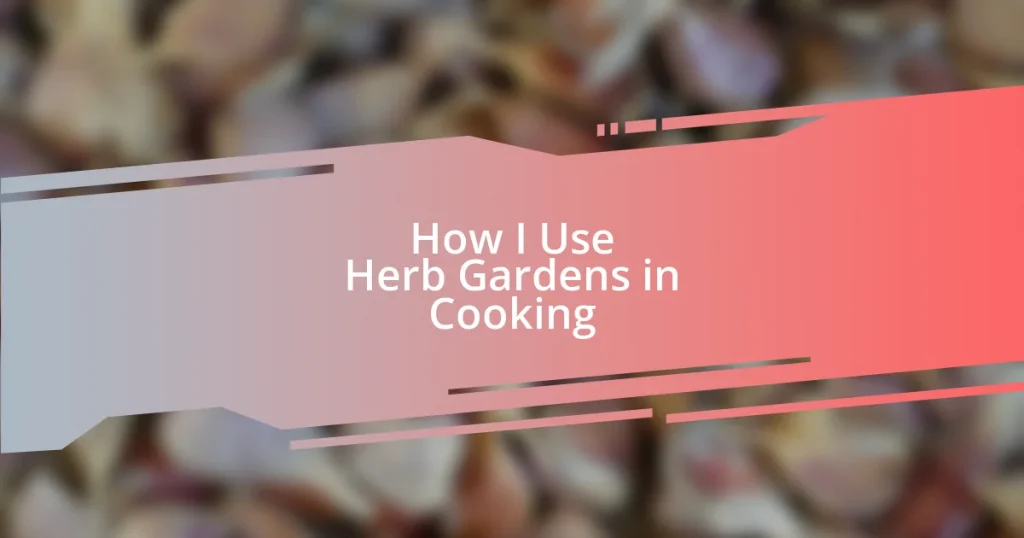Key takeaways:
- Harvest herbs in the morning for optimal flavor; snip top leaves to promote new growth and use sharp tools to avoid bruising.
- Incorporate fresh herbs by adding delicate ones at the end of cooking and sturdier herbs earlier to balance flavors in dishes.
- Preserve herbs through freezing, drying, salting, or making pesto, each method enhancing their unique flavors for future use.

Harvesting Herbs for Maximum Flavor
When I harvest herbs, timing is everything. I’ve learned that picking them in the morning, after the dew has dried but before the sun gets too strong, results in the most vibrant flavors. Can you imagine the richness of that first taste of basil or cilantro? It’s like nature’s little secret, waiting for us to uncover it.
I also pay close attention to the parts of the plant I’m cutting. For instance, snipping the top leaves encourages new growth, and I’ve found that the tender young leaves often pack a more delicate flavor than the older ones. To me, it’s a rewarding dance: the more I harvest, the more my little herb garden flourishes!
Another tip I swear by is to use a sharp pair of scissors or shears. I’ve made the mistake of using dull tools, which can bruising the leaves and robbing them of their aromatic essence. The joy I feel when I open a jar of my homegrown oregano in winter is a constant reminder of why it’s so important to treat those herbs with care right from the harvest. Managing to unlock those intense flavors is what keeps me coming back to my garden week after week!

Incorporating Fresh Herbs in Recipes
When it comes to incorporating fresh herbs in recipes, I find that less is often more. I love starting by adding a pinch of chopped parsley or basil to my sauces and dressings. This small adjustment can elevate the dish with vibrant color and fresh flavor. It’s surprising how a handful of herbs can transform a mundane meal into a culinary delight. Have you ever drizzled olive oil over a simple tomato salad and then sprinkled it with fresh basil? That burst of flavor is nothing short of magic.
On the other hand, I’ve had experiences where I’ve gone a bit overboard—think too much rosemary in a roast. In my kitchen, learning to balance flavors has been a delightful process. Each herb has its personality, and I’ve learned to appreciate that. For instance, thyme adds a woodsy depth while dill brings bright notes to a creamy dip. Finding that perfect harmony is what makes cooking feel so rewarding!
When you’re experimenting with fresh herbs, think about how their flavors develop through cooking. For example, I often add delicate herbs like cilantro or chives at the end of cooking for a fresh burst, while sturdier herbs such as rosemary and sage can withstand longer cooking times. This approach allows me to enjoy the full spectrum of flavors each herb offers.
| Herb Type | Best Usage |
|---|---|
| Delicate Herbs (e.g., Basil, Cilantro) | Best added fresh at the end of cooking or as a garnish |
| Sturdy Herbs (e.g., Rosemary, Thyme) | Can be added early to infuse flavor in dishes |

Preserving Herbs for Future Use
When it comes to preserving herbs for future use, I’ve found that different methods can highlight unique aspects of each herb’s flavor. For example, I’ve often frozen basil and cilantro as ice cube portions in olive oil, creating little flavor bombs that brighten up sauces or soups in the colder months. There’s something quite fulfilling about opening my freezer and finding these fragrant cubes, each one filled with memories of summer’s warmth.
Here are some optimal methods to preserve herbs that I’ve personally enjoyed:
- Freezing: Chop herbs and mix with a bit of oil or water in an ice tray. Once frozen, transfer the cubes to a freezer bag.
- Drying: Hang herb bundles upside down in a cool, dark place. Once dry, crumble the leaves into jars for easy use.
- Salting: Layer fresh herbs with coarse salt in a jar. This method results in a flavorful herb salt, perfect for seasoning dishes.
- Pesto: Blend herbs like basil with nuts, cheese, and oil. A batch can be frozen in small containers for a quick flavor addition later.
My own experience with drying made me appreciate the patience it took. The moment I crumbled my home-dried thyme into a dish, the fragrance took me right back to my garden, reminding me of the hard work and delightful surprises that come with preserving each season’s harvest. Each preservation method offers a different taste adventure, allowing me to enjoy my garden’s bounty long after the last leaves fall.

Creative Serving Ideas with Herbs
Getting creative with serving herbs is one of my favorite aspects of cooking. One time, I decided to garnish my homemade soup with a sprinkling of fresh chives and a few cilantro leaves. It transformed not only the look of the dish but also added layers of flavor that complemented the broth beautifully. Have you ever thought about how a simple garnish can turn an ordinary meal into something special?
Another delightful idea is to use herb-infused oils for drizzling. I remember experimenting one weekend by steeping garlic and rosemary in olive oil and using it to dress a warm roasted vegetable platter. The aroma was intoxicating, and my guests couldn’t stop asking what the secret was! It’s these little touches that make a significant impact, and every time I pour that oil, it’s like a burst of my garden’s essence on a plate.
Lastly, incorporating fresh herbs into drinks has become a fun twist in my kitchen. I play with muddling mint or basil into lemonades and cocktails, creating refreshing sips that are loaded with flavor. The first time I tried a basil lemonade, it was a revelation; the herbiness paired surprisingly well with the tartness of the lemon. Have you tried experimenting with herbs in beverages? It’s a surprisingly delightful way to elevate your culinary repertoire!













